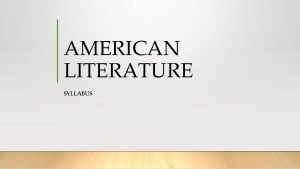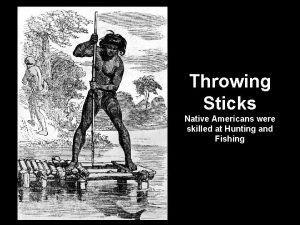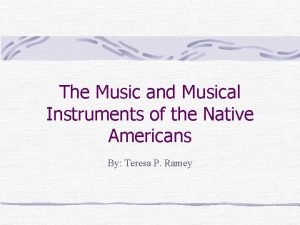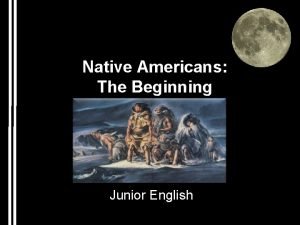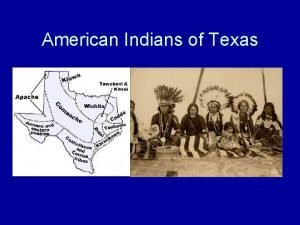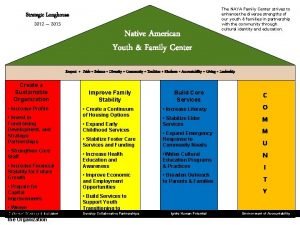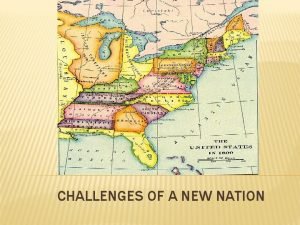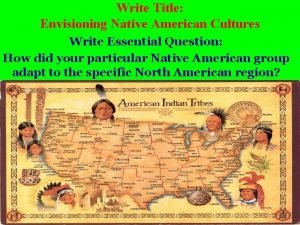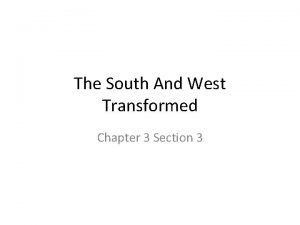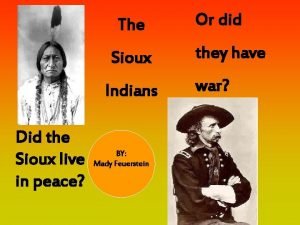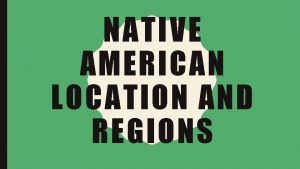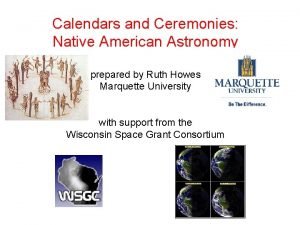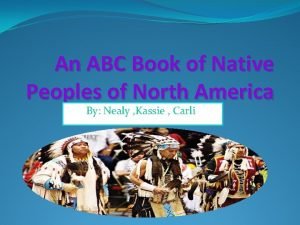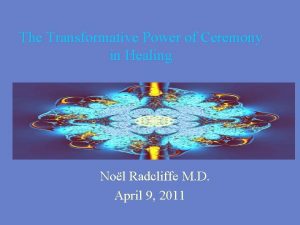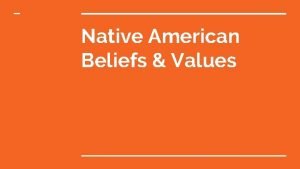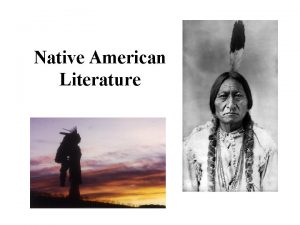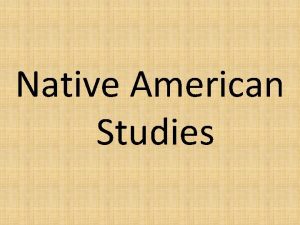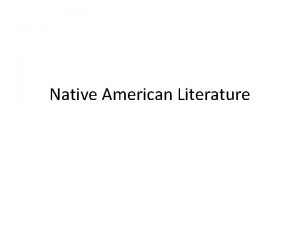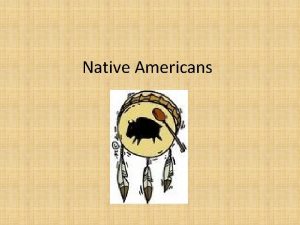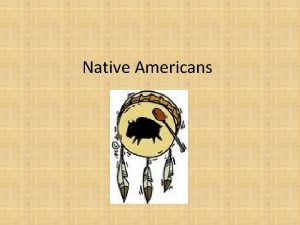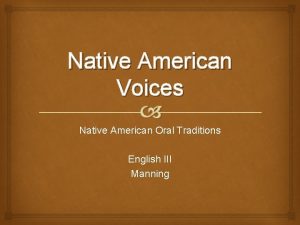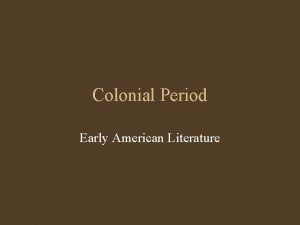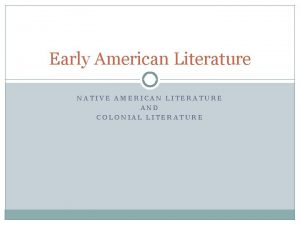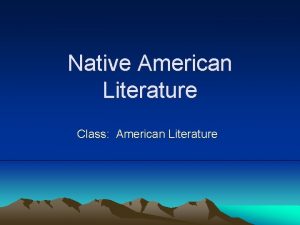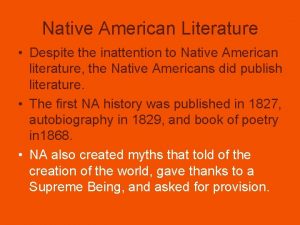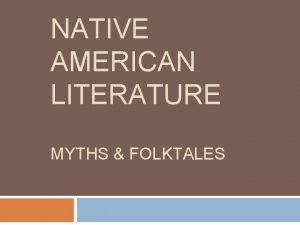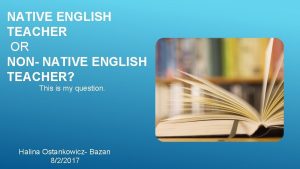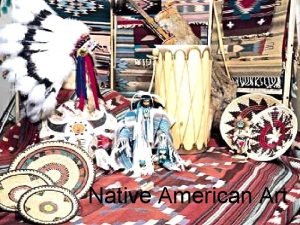Native American Literature English 11 American Literature Mr






















- Slides: 22

Native American Literature English 11 American Literature Mr. Cornelius


Historical & Cultural Context • Our American identity as we know it is a product of our past. Our class will focus on literature which reveals how we arrived at our society and culture today. • We study Native American literature out of a respect for the indigenous cultures who were here before the European explorers as well as a respect for their cultural and literary influence throughout the years.

Indigenous Americans inhabited this continent before anyone else. They endured many invasions from the Spaniards for the following primary reasons: 1. land 2. gold 3. crops (all of which were plentiful)

• Once explorers and settlers decided to stay and start building the natives could do nothing although they usually tried to fight back. • Natives had a completely different set of values and traditions: - some wouldn’t fight back until they realized they would lose their land completely - they lived off the land held it in high regard; earth was the mother - they never used more than they needed and they never wasted anything

• The settlers flagrant ways and intruding methods of desecrating the land came as a huge blow to the Native Americans. • The Europeans also brought disease that natives were never exposed to before, which brought actual physical desecration to their people. • Over time (hundreds of years) land was progressively taken away from them and they were not only robbed of their sacred land the traditions it embodied for them, but they were forced into assimilating into the emerging European-American culture.

• Indian removal was legalized with the Removal Act of 1830, which stipulated: 1. the tribe “consent” to move 2. new land was to replace the old

• This “manifest destiny” resulted in what would later be known as the Trail of Tears, or the mass forced exodus of thousands of Native Americans from their sacred land to government reservations. • From there, efforts to “civilize” them so that they could be mainstreamed into society continued.

• Indian children were sent to boarding schools far away from the reservations so that the authority of their parents/elders would be undermined. Language, and consequently, cultural identity was legally confiscated. Children were harshly punished for using their own language and were separated tribally to immerse them in English only. • Although great strides have been made in recent years for Indian Sovereignty, Native Americans continue to struggle because of the events of the past.

Storytelling & Oral Tradition • Long before European explorers came to North America, Native Americans had a rich literary tradition of their own. Their stories, histories, and legends were shared and preserved through oral tradition. The storyteller is one whose spirit is indispensable to the people.

• The Native Americans spoke hundreds of languages and lived in incredibly diverse societies with varied mythological beliefs. Despite their differences, their cultures and literary traditions had the following common elements: � lack of a written language � they believed in the power of words and they relied on memory, rather than writing to preserve their texts • in this regard, these stories are not defined by the boundaries of written language; there are no ending pages and they are not contained within a limited, concrete, physical source.

� these stories belong to the collective people/the tribe � the oral tradition was a performance and is offered to the audience as dramatic events in time � yet, the audience is not passive and has a role in bringing out the story � the storyteller is very important to culture and is one of the most honored and respected members of the tribe/society � the relationship between the storyteller and the audience is established through: voice emphasis, gestures, use of space, eye contact, and the audience can be representative of the characters in the story � there is no known original author � these stories are open to personal interpretation

These oral stories include the following types of texts: � cultural information (beliefs about social order and appropriate behavior) � historical accounts including migrations: how people got to where they are � lessons describe how and why things are the way they are � creation stories and the origins of societies (beliefs about the nature of the physical world)

NOTE = While oral stories are meant to be passed down through generations verbally, it is important to remember that written transcripts are not exactly representative of the oral performance. But a translation/ transcription of the stories is the closest we can come to sharing the Native American culture and tradition.

These oral stories were chanted, spoken, sung and repeated over and over until embedded into the memories of the next generations. The Native American oral tradition was the only way to pass on tribal history, heritage, and cultural practices. In order to continue hundreds of years of a tribe’s history the young must listen and remember the stories the elders tell and then pass them on.

Some Dominant Themes & Motifs: • relationships between humans and animals • respect and reverence for mother earth and nature • land as the strength of the people • village/community/tribe as sovereign • cyclical patterns: renewal and continuance • importance of tribal traditions and history

Native American Wisdom • “The earth was created by the assistance of the sun, and it should be left as was…The earth and myself are of one mind. ” --Chief Joseph, Nez Perce • “All things are connected…Whatever befalls the earth befalls the sons of the earth…This we know. Man did not weave the web of life, he is merely a strand in it. Whatever he does to the web he does to himself. ” --Chief Seattle

• “The Earth our Mother is holy and should be treated as such…all forms of life are our brothers and sisters and have to be respected…Life is a holy, sacred experience…we must live our lives as a religion, that is, with a constant concern for spiritual relationships and values…we must lives that bring forth both physical and spiritual beauty. All life has the potentiality of bringing forth Beauty and Harmony, but [humans] in particular [have] also the ability to bring forth ugliness and disharmony. ” --Forbes

“You have noticed that everything an Indian does is in a circle, and that is because the Power of the World always works in circles, and everything tries to be round. In the old days when we were a strong and happy people, all our power came to us from the sacred hoop of the nation, and so long as the hoop was unbroken, the people flourished. The flowering tree was the living center of the hoop, and the circle of the four quarters nourished it. The east gave peace and light, the south gave warmth, the west gave rain, and the north with its cold and mighty wind gave strength and endurance. This knowledge came to us from the outer world with our religion. Everything the Power of the World does is done in a circle. The sky is round, and I have heard that the earth is round like a ball, and so are all the stars. The wind, in its greatest power, whirls. Birds make their nests in circles, for theirs is the same religion as ours. The sun comes forth and goes down again in a circle. The moon does the same, and both are round. Even the seasons form a great circle in their changing, and always come back again to where they were. The life of a man is a circle from childhood to childhood, and so it is in everything where power moves. Our tepees were round like the nests of birds, and these were always set in a circle, the Nation’s hoop, a nest of many nests, where the Great Spirit meant for us to hatch our children. ” —Black Elk, Oglala Sioux Holy Man, 1863 -1950

• “Plants are thought to be alive, their juice is their blood, and they grow. The same is true of trees. All things die, therefore all things have life. Because all things have life, gifts have to be given to all things. ” -William Ralganal Benson Pomo • “This rock did not come here by itself. This tree did not come here by itself. There is one who made all this, Who shows us everything. ” --Yuki

• “The American Indian is of the soil, whether it be the region of the forests, plains, pueblos, or mesas. He fits into the landscape, for the land that fashioned the continent also fashioned the man for his surroundings. He once grew as naturally as the wild sunflowers; he belongs just as the buffalo belongs. ” --Luther Standing Bear, Oglala Sioux Chief

For Further Reading & Study: • The Way to Rainy Mountain and House Made of Dawn, by N. Scott Momaday • The Surrounded, by D’Arcy Mc. Nickle • Reservation Blues and The Lone Ranger and Tonto Fistfight in Heaven, by Sherman Alexie • Storyteller and Ceremony, by Leslie Marmon Silko • Neither Wolf Nor Dog, by Kent Nerburn • Bury My Heart at Wounded Knee, by Dee Brown • Bury My Heart at Wounded Knee, HBO film • Bless Me, Ultima by Rudolfo Anaya
 What are the characteristics of early american literature
What are the characteristics of early american literature Characteristics of native american literature
Characteristics of native american literature Southern literature syllabus
Southern literature syllabus Hopi rabbit stick
Hopi rabbit stick Native american musical instruments
Native american musical instruments First people in the world
First people in the world Native american religious beliefs
Native american religious beliefs Colours of the medicine wheel
Colours of the medicine wheel Native american dwellings
Native american dwellings Candy named after indian burial grounds
Candy named after indian burial grounds Native american youth and family center
Native american youth and family center Native connections housing
Native connections housing Native american important facts
Native american important facts Native american cultural areas
Native american cultural areas What three circumstances hurt native americans
What three circumstances hurt native americans Sioux writing
Sioux writing Native american skyscraper workers
Native american skyscraper workers Native american tribes in the united states
Native american tribes in the united states Native american cultural areas
Native american cultural areas Native american calendars
Native american calendars Native american abc book
Native american abc book Native american letting go ceremony
Native american letting go ceremony Native american morals and values
Native american morals and values


